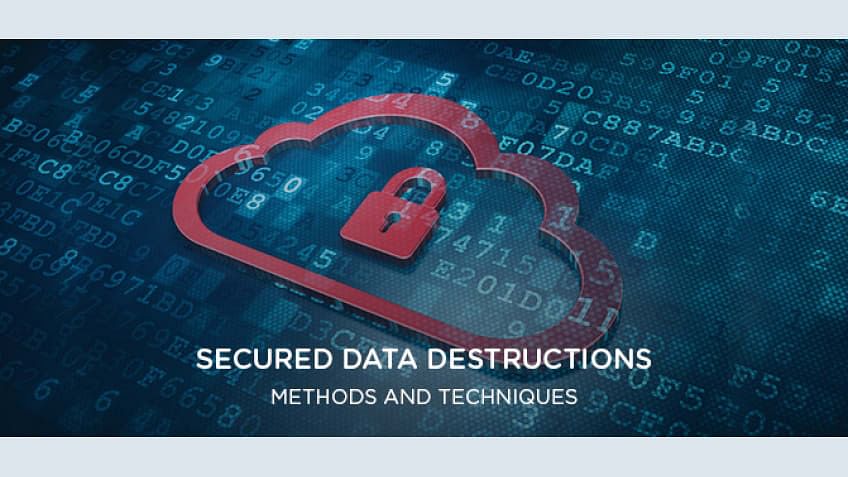The Importance of Effective Data Destruction Practices in Safeguarding Sensitive Information and Ensuring Computer Safety
In a period where data violations are increasingly typical, the importance of reliable information devastation practices can not be overemphasized. Organizations face significant risks when sensitive info is inadequately thrown away, possibly resulting in unapproved access and extreme financial effects. Executing robust data devastation approaches not only alleviates these dangers but likewise aligns with lawful conformity demands, guaranteeing that organizations maintain their online reputation and foster client trust. The question stays: what particular techniques can be employed to enhance these techniques, and just how can companies successfully incorporate them into their general cybersecurity structure?
Comprehending Data Damage
Comprehending information devastation is critical in today's digital landscape, where delicate details can quickly be jeopardized. Efficient data devastation entails not just removing files but guaranteeing that information is irretrievable with detailed approaches. This procedure is vital for organizations that deal with private client info, intellectual home, or inner records, as any type of breach can cause extreme financial and reputational repercussions.
Information destruction includes various techniques, consisting of shredding physical media, degaussing magnetic storage space gadgets, and utilizing software-based options that overwrite data multiple times. Each approach offers a details objective and needs to line up with the sensitivity of the details being gotten rid of. Physical damage is frequently favored for tough drives consisting of highly private data, while software program techniques may suffice for much less delicate details.
In addition, adhering to sector standards and laws, such as the General Data Security Law (GDPR) or the Medical Insurance Mobility and Liability Act (HIPAA), is imperative for compliance and to minimize legal dangers. Organizations has to develop a robust information devastation policy, train workers on ideal practices, and on a regular basis audit their treatments to ensure that all sensitive details is gotten rid of securely and successfully.
Threats of Inadequate Practices
Inadequate data devastation methods subject companies to considerable risks that can have far-ranging consequences. When sensitive information is not appropriately gotten rid of, it stays at risk to unauthorized access, which can result in data breaches and identity burglary. Such cases not just compromise the safety and security of people yet additionally stain the company's credibility, resulting in a loss of consumer trust fund and prospective financial effects.
Moreover, regulatory conformity is progressively strict in several markets. Failure to abide by information devastation regulations can cause hefty penalties and lawsuits versus companies. These charges can stress funds and draw away focus from core organization operations.
Additionally, the misuse of recurring data can result in intellectual residential property theft or company reconnaissance, jeopardizing affordable advantages (data destruction). The influence of inadequate information destruction expands beyond immediate monetary losses; it can likewise cause long-lasting damage to brand stability and market position

Organizations have to acknowledge that information safety is not solely about protecting against violations; it likewise includes the accountable monitoring of information throughout its lifecycle. Disregarding reliable data destruction methods can have devastating ramifications, highlighting the requirement for durable measures to alleviate these dangers.
Finest Practices for Data Destruction
Carrying out effective information devastation methods is vital for protecting sensitive details and maintaining compliance with governing criteria. Organizations must take on a multi-faceted method to make sure that information is irretrievable, therefore preventing unauthorized gain access to and prospective breaches.
First, data must be classified based upon level of sensitivity, permitting organizations to apply proper devastation approaches customized to the degree of risk. For digital data, making use of software-based data-wiping devices that abide by sector standards can effectively overwrite existing data. Physical destruction techniques, such as shredding or degaussing, are essential for tools that store delicate info, guaranteeing full obliteration.
Developing a clear data retention policy is crucial, outlining how much time different kinds of details must be kept before destruction. Normal audits of information storage space systems are likewise needed to determine unneeded or out-of-date data needing elimination.
Furthermore, training workers on the significance of data devastation and the specific methods to follow fosters a society of protection within the company. Maintaining documents of data devastation refines offers responsibility and sustains conformity with internal policies and exterior regulations. By sticking to these ideal methods, companies can considerably minimize the risks related to information exposure.
Legal and Compliance Factors To Consider

Failing to adhere to these guidelines can cause serious charges, consisting of significant penalties and reputational damage. Organizations has to implement a durable data damage policy that aligns with these legal frameworks and provides clear standards on the correct approaches of information disposal, whether physical shredding or digital wiping.
Furthermore, maintaining documentation of information destruction activities is vital for demonstrating compliance throughout audits or inspections. By focusing on lawful and compliance considerations, companies can boost their information protection stance and foster trust fund with stakeholders and clients, ultimately adding to a more safe and secure information administration setting.
Advantages of Effective Data Destruction
Effective data devastation techniques expand beyond mere compliance; they provide significant advantages to organizations that prioritize them. By guaranteeing that delicate details is irretrievably damaged, companies reduce the risk of information breaches and the prospective financial consequences connected with them. This positive approach not only safeguards versus unauthorized accessibility however additionally boosts the general dependability of the company in the eyes of clients and stakeholders.
Implementing durable information damage techniques, such as physical destruction of storage space tools or his response sophisticated information wiping methods, adds to the strengthening of an organization's cybersecurity stance. data destruction. It decreases the likelihood of intellectual building theft and protects exclusive information, consequently keeping an one-upmanship out there

Final Thought
In conclusion, effective data destruction methods are crucial for safeguarding delicate details and boosting total computer system protection. Ultimately, a commitment to robust data destruction techniques promotes a culture of obligation, consequently enhancing an organization's cybersecurity stance and keeping client trust.

Comments on “Comprehending the Duty of Data Destruction in Strengthening Cyber Security Defenses”